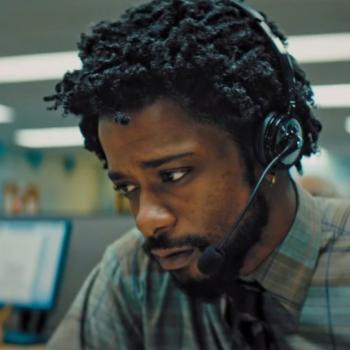It’s Halloween time, so as usual I’m watching a lot of horror movies. Maybe this is why, by a mechanism purely driven by my own absurd imagination, I’ve loosely associated Meet the Mormons with the horror genre. Specifically, as a Dawn of the Dead-esque sequel to the 1922 silent film, Trapped by the Mormons.
Disclaimer: I have not seen Meet the Mormons, and this is not as a criticism of the film itself, but an entertaining thought experiment meant to analyze the evolution of Mormons in cinema over the last 90 years. Trapped by the Mormons kicked off a bizarre relationship between Mormonism and film that culminates in the Church’s first official wide-released film.
Trapped was introduced to me in my after-school seminary class. Our instructor brought it up in conversation one day, and after we begged him to show it to us he relented and brought in a VHS copy on a Friday. The class was enthralled, and I remember distinctly the visuals of the missionary in the film — a dark, handsome man with typical silent-era heavy eye makeup who used hypnosis to lure unknowing young women into his caravan, where he takes them back to Salt Lake City to live in his harem. Polygamy was no secret in my Mormon upbringing, but it was the first time I’d ever seen the word “harem” associated with it, which only added to the exotic and bizarre tone the film conveyed.
Our seminary teacher was essentially showing us an early example of an anti-Mormon film, yet the evolution of the Church over time rendered the criticisms the film lobbed at Mormons *weak. I imagine in fifty years, seminaries will watch The Godmakers with the same amusement. This same teacher also told us that the hypnotic stare used by the missionary in the film inspired Bela Lugosi’s gaze in Dracula, though it’s probably impossible to confirm this. I like that tidbit, though. It elevates an otherwise obscure piece of cinema history to urban legend, small in its own right but hugely influential. Like a silent film version of The Velvet Underground—not very many people saw the film, but those who did went on to star in monster movies of their own.
Part of my original fascination rested on my struggle to imagine Mormonism as a subject important enough to find its way into a film in the silent era. At that point, God’s Army was brand new and the whole idea of a Mormon movie was groundbreaking to my 14 year old Peter Priesthood self. It didn’t matter that Trapped was an anti-Mormon film—in fact, the “Mormon as a sex-crazed villain” idea made it even cooler. I’m not trying to exaggerate the cultural significance of Trapped by the Mormons, because I think it is marginal at best, but imagine watching Star Wars for the first time, finding out the Darth Vader is a Sith Lord, and thinking, “hey – I’m a Sith Lord. Can I be that dangerous? Will people see me as that dangerous?” I imagine it’s almost like that, if there’s some galaxy where Sith Lords are known for not drinking coffee and Donny Osmond.
Whatever the motivations behind it, Trapped by the Mormons projected actual anxieties about Mormons during the time. But then, what if those fears were justified, even the insane and paranormal ones? What if Mormons were experts in hypnotism and mind control, and the Mormons in the 1920s continued in their sinister quest to enslave humanity. Now, they have a new tactic.
Imagine this scenario. After the ominous menace of hypnotic kidnapper missionaries seen in Trapped, the Mormons slowly grow their numbers over the decades, secretly creeping into communities by recruiting families one by one until they’ve normalized their previously spooky religion. Meet the Mormons is a kind of cerebral, Invasion of the Body Snatchers kind of horror. The Mormons’ magic on society has worked, now they’ve assimilated. No longer the creeping threat of hypnotic villains, now they are your friends. Your neighbors. They’ve infiltrated.
I’m being intentionally silly here. I have no real animosity toward Meet the Mormons. Living outside the U.S. means I don’t exactly have the means to see the film, and I can’t imagine even my most film-enthusiastic Irish friends would bother to see it with me. Essentially, I’m not sure what audience Meet the Mormons is for, other than Mormons themselves. Which is fine, really.
But like everything else about Mormonism in the 20th century, the new church-produced documentary shows that we’ve undergone quite a conversion in the public’s eye. Meet the Mormons is the first official big-screen portrayal of the religion by the religion, but the Mormon image can be traced back much further than that, and there are plenty of scholars who’ve explored Mormons in cinema. But now that we’ve gone mainstream, I think we should take it back to our dangerous, horror roots. Or maybe, instead of trying to prove we’re like everyone else, embrace our weirdness. Why shouldn’t the undesirable portrayal of Trapped by the Mormons be as part of our history as Meet the Mormons? If not permanently, at least during the spookier time of year. After all, if it is true that Bela Lugosi’s Dracula was inspired by a hypnotic Mormon, we have as much claim to Halloween as anyone.










